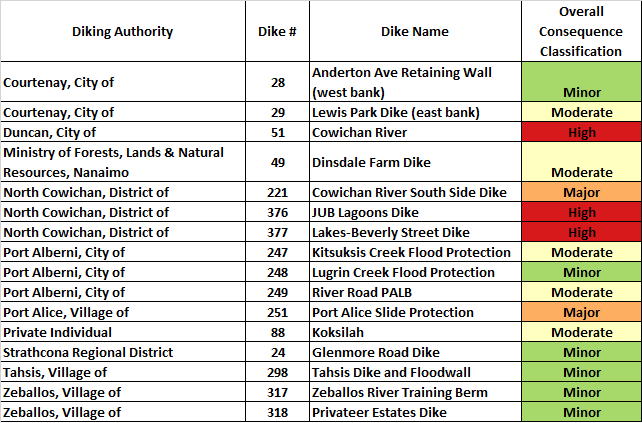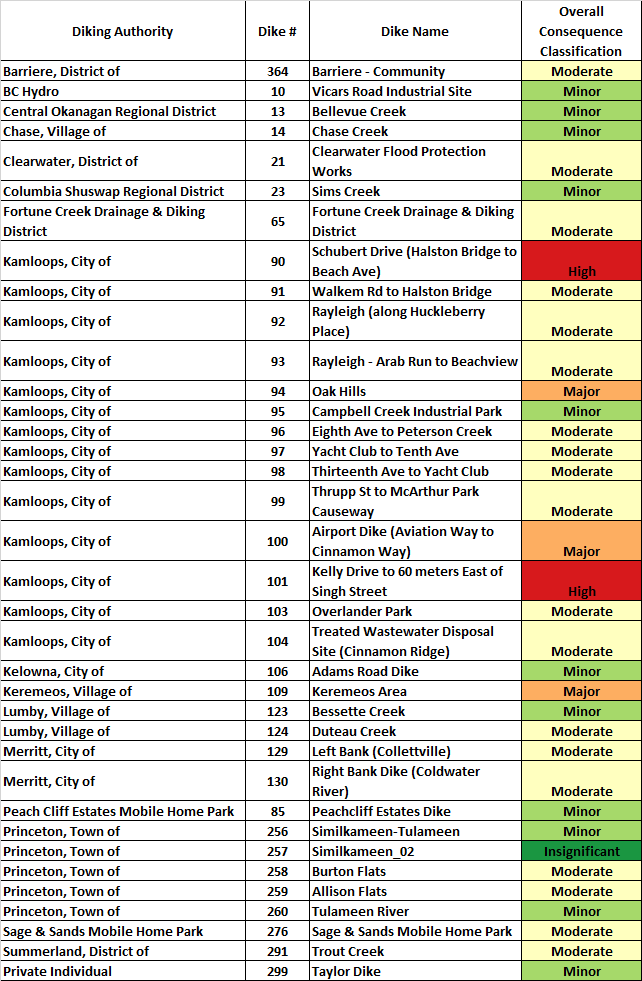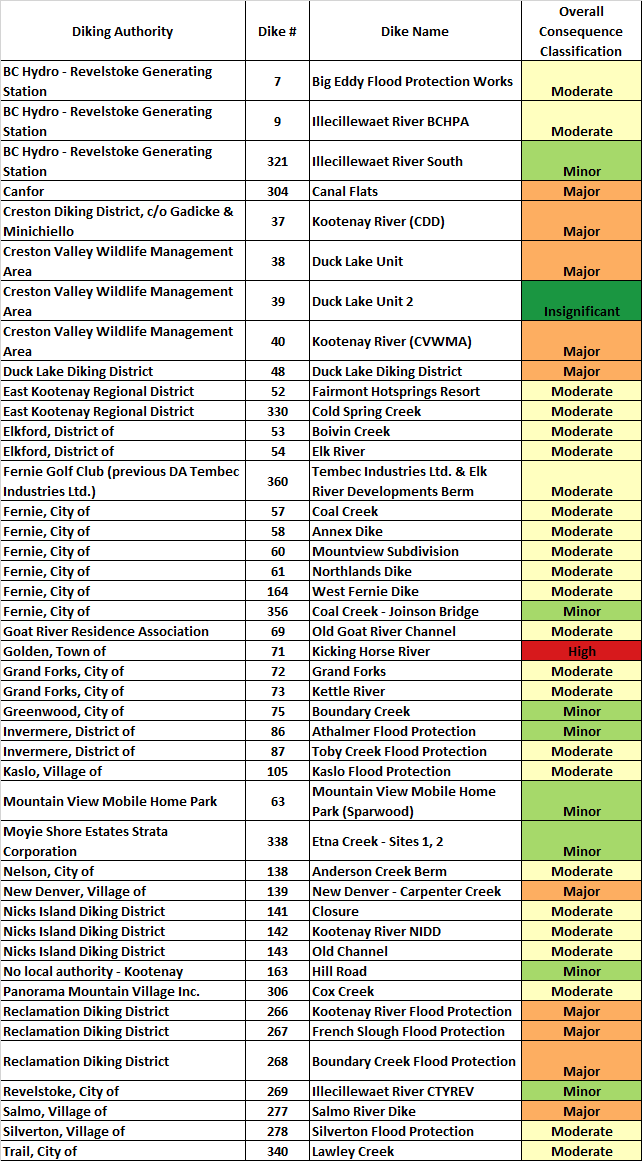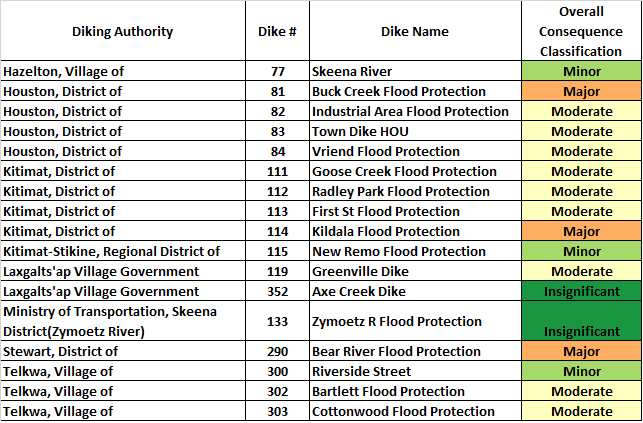Dike management
As defined in the Dike Maintenance Act, a dike is an embankment, wall, fill piling, pump, gate, floodbox, pipe, sluice, culvert, canal, ditch, drain, or any other thing that is constructed, assembled, or installed to prevent the flooding of land. In British Columbia, dikes are works that address major flood hazards.
There are more than 200 regulated dikes in B.C. with a total length of over 1,100 kilometres, protecting 160,000 hectares of valuable land.
The Lower Mainland is dependent on the integrity of:
- 600 kilometres of diking
- 400 floodboxes
- 100 pump stations
On this page
- History of dikes in B.C.
- Dike construction
- Dike safety program
- Dike assessment
- Dike consequence classification
History of dikes in B.C.
Diking in British Columbia started as early as 1864.
In 1894, the greatest flood on record occurred affecting extensive areas in the southern half of the province. Fortunately, development was still sparse and relatively little damage was caused. Later, as floodplain development continued, dikes were increasingly relied upon to protect these areas.
British Columbia’s second most damaging flood occurred in 1948 when a few dikes failed, resulting in:
- Several casualties
- Destruction of about 2,000 homes
- Evacuation of 16,000 residents
- Approximately $210 million (present day value) in damages
A 2015 study released by the Fraser Basin Council determined that a reoccurrence of the 1894 flood today could cause approximately $23 billion dollars in damages to the Lower Mainland. This emphasizes the importance of having properly designed, constructed and maintained dikes.
Dike construction
Construction of new dikes, or upgrading of existing orphan dikes, will only be approved if:
- The local government has passed Council or Board resolution to become the diking authority and become responsible for ownership, operation and maintenance of the dike
- The diking authority acquires and maintains full legal access to the structure(s) through land ownership (fee simple) or registration of statutory right-of-way(s)
The following document provides guidance on how to manage dikes within the province:
Further guidance on the primary aspects of implementing and managing dikes:
- Learn more about the dike approvals process
- Learn more about dike design & construction
- Learn more about dike operation & maintenance
- Learn more about annual dike inspections
Dike safety program
Provincial responsibilities and general supervision relative to the construction and maintenance of dikes lies with the offices of the inspector of dikes and deputy inspectors of dikes.
Their responsibilities include:
- Administering the Dike Maintenance Act
- Setting dike design and maintenance standards and other criteria
- Promoting dike management best practices
- Monitoring and auditing management of works by local diking authorities
- Approving changes to dikes and new dikes
- Providing technical expertise for high risk diking issues
Dike assessment
The B.C. Government and partners undertook an assessment of 74 dikes in the Lower Mainland. This assessment evaluated the level of protection provided by the dikes and identified major deficiencies.
Dike consequence classification
The Province has classified the exposure consequence level from a potential major dike failure, for each dike in B.C. regulated under the Dike Maintenance Act and under the control and care of a diking authority. This classification is only a snapshot in time (2019) and may not reflect future conditions such as new developments or new critical infrastructure built in the area protected by the dike.
Consequence is the total effect of a hazardous event, composed of exposure (people and assets in the flood prone area), vulnerability (the susceptibility of people, assets or systems to the impacts of flooding) and capacity (the ability to manage and reduce flood risks and strengthen flood resiliency). The classifications provided here are based on evaluating only the exposure component of consequence (Tier 1).
Consequence is one of the major components of risk, with the other component being the probability of occurrence. This classification does not consider the probability of occurrence and is not considered a risk assessment.
These consequence classifications are intended for use for the following:
- A consistent comparison of consequence from a potential failure of each dike
- Applicability of the Seismic Design Guidelines for dikes in seismically active areas
- Input for further future studies, including data gap identification, policy development, risk reduction investment evaluation, and emergency management planning
- Framework which may be used and adapted for future risk assessment work
The classification rankings show only the overall ranking. This ranking is determined by combining and weighting scores from the individual categories of people, economy, agriculture, environment, and cultural heritage. The weighting of each consequence category is based on the confidence in the data, the understanding of potential impacts and the importance for socio-economic recovery. For further details please consult the full report.
Dike consequence classification by region
Select the region to see the consequence classification for DMA-regulated dikes.
The consequence levels are as follows (from the lowest to the highest):
Insignificant, Minor, Moderate, Major, High
West Coast

South Coast (incl. Lower Mainland)

Thompson-Okanagan (Southern Interior)

Kootenay

Cariboo

Skeena

Omineca-Northeast (Peace-Omineca)

The documents below provide the full dike consequence assessment that was undertaken. It provides details on the development of the consequence classification framework, the classification process, recommended classification level, and its limitations.
Contact information
For more information about the Dike Safety Program, please contact the deputy inspector of dikes in your area.
